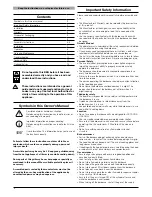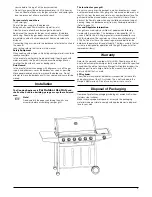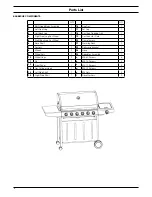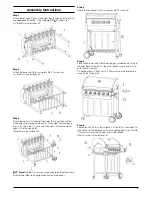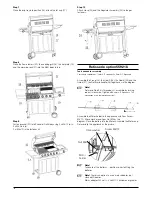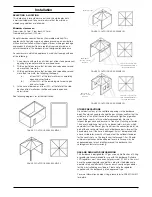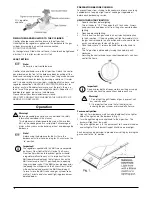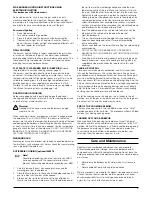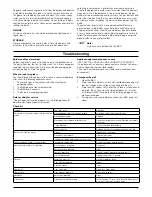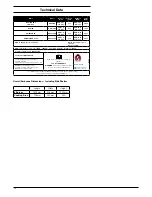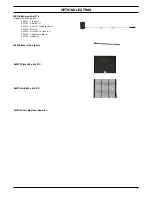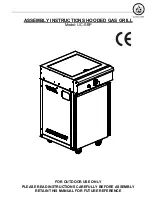
10
In order to extend the life and maintain the condition of your
barbecue, we strongly recommend that the unit is covered when
not in use, especially during the winter months.
STAINLESS STEEL CARE AND CLEANING ADVICE
Cleanliness and stainless steel are closely related. Stainless steel
performs best when clean - cleanliness is essential for maximum
resistance to corrosion and to maintain the good looks and life of
your BBQ.
TYPES OF SURFACE CONTAMINANTS
Fingerprints and Stains
Fingerprints and mild stains resulting from normal use are the most
common surface contaminates. They can be removed with a glass
cleaner or with a soft rag. This should be followed by a thorough
warm water rinse.
Dirt
Like any surface that is exposed to the environment especially in
coastal areas, stainless steel can get dirty. Cleaning with warm
water with or without a gentle detergent is sufficient. Next in
order are mild non-scratching abrasive powders such as typical
household cleaners. These can be used with warm water, bristle
brushes, sponges, or clean cloths. Carbon steel brushes or steel
wool should be avoided as they may leave particles embedded on
the surface which can lead to RUSTING. Cleaning should always be
followed by rinsing in clean hot water.
Grease
Grease may soil stainless steel surfaces in food preparation. These
soils may be mildly corrosive if left or may not allow the surface
to maintain passivity, and so regular removal is a necessity for the
appearance.
TYPES OF CLEANERS AND METHODS
Consider the possibility of scratching and the potential for post-
cleaning corrosion caused by incompletely removed cleaners. Avoid
using abrasive cleaners unless absolutely necessary.
Clean Water and Wipe
A soft cloth and clean warm water should always be the first choice
for mild stains and loose dirt and soils. A final rinse with clean
water and a dry wipe will complete the process and eliminate the
possibility of water stains.
Household Cleaners
Household cleaners fall into two categories: detergent (non-
abrasive) and abrasive cleaners. Abrasive cleaners are more
effective but introduce the possibility of scratching the surface. A
neutral cleaner low in chloride is essential. The cleaning method
generally employed with these cleaners is to apply them to the
stainless surface and follow by cloth wiping in the direction of the
grain or polish lines (not across them). The cleaned surface should
be thoroughly rinsed with clean water and wiped dry with a soft
cloth if water streaking is a consideration.
CARE OF STAINLESS STEEL IN YOUR BBQ
Your BBQ features Stainless Steel components, using moderate
grade Stainless Steels. All Stainless Steel grades require a level
of care and protection to retain their appearance. Stainless Steels
are not immune to corrosion and neither are they maintenance-
free, contrary to popular public perception. Even the highest
marine grades of Stainless Steel require frequent cleaning to avoid
oxidation and other corrosive issues.
Modern tastes dictate that your BBQ features Stainless Steel with a
brushed finish. This brushed finish is attained by running Stainless
Steel sheets through an abrasive process that removes the mirror
finish and leaves the brushed finish. Brushed-finish Stainless
Steel requires frequent cleaning and care, to maintain its quality of
appearance. Without adequate care it is realistic to expect that it will
show signs of corrosion in time.
Stainless steel is definitely not a maintenance-free material.
Cleanliness and Stainless Steel are closely related.
The cleaner stainless steel can be kept while in storage or during
use, the greater the assurance of optimum corrosion resistance. In
order to maintain the good looks and life of your BBQ, follow these
summary tips on the care of stainless steel:
•
When new or when cleaned and dried, we recommend the
owner apply a thin coat of Olive Oil to stainless steel surfaces
which should then be polished in. The Olive Oil will help greatly
in protecting the stainless steel from corrosive contaminants
and assisting removal of finger prints and other marks, keeping
the appearance of the stainless steel in new condition. The
Olive Oil coating also makes further polishing easier.
•
Use clean, soft cloths or sponges to clean your grill.
•
Carbon steel brushes or steel wool should never be used.
•
Do routine cleaning of exposed surfaces.
•
After cleaning, rinse thoroughly with water.
•
Cleaning with chloride-containing detergents must be avoided.
•
On polished finishes, rubbing or wiping should be done in the
direction of the polish lines, NOT across them.
CAST IRON COOKING SURFACES
Before cooking with the grill, flat plate or deep dish (if supplied with
your BBQ) clean these with hot soapy water to remove any oil or
residue from the packaging or manufacturing process. Wash with
clean water and let the plates dry naturally. Prior to lighting your
BBQ place them back into the BBQ. Then after lighting your BBQ,
let the plates warm up slowly over a period of 30 minutes, during
this time increasing the heat. You will notice slight vapors rise from
the plates, this is natural as residues are burned off. Turn off your
BBQ to allow the plate to cool slightly. The plates can now be
prepared with the addition of cooking oil. Take care that the plates
are not at a temperature where adding the oil will cause a hazard.
Brush the oil over the plate, allowing the oil to be absorbed into the
surface. Allow the plate to fully cool, then remove any excess oil. the
BBQ is now ready. Repeat the above to keep the plate and grill in a
ready condition after each BBQ session.
PORCELAIN ENAMEL COOKING SURFACES
Porcelain Enamel surfaced items should be treated with care and
should not be cleaned with an abrasive cleaner or scratchy cleaning
item. Surfaces will crack or chip if hit or dropped. Porcelain Enamel
surfaces should NOT be regarded as ‘Non-stick’, use of cooking
oil is required as normal. Food will likely stick to an overheated or
un-oiled enamel surface. The surface will be more easily cleaned by
first soaking overnight.
BURNER MAINTENANCE
Provided that they are operating correctly, in normal usage, burning
off the residue after cooking will keep the burners clean. The
burners should be removed and cleaned annually, or whenever
heavy build-up is found, to ensure that there are no signs of
blockage (debris, insects) in either the burner portholes, the primary
air inlet, or the neck of the stainless steel burners. Use a pipe
cleaner to clear obstructions. When refitting the burners, be
careful to check they are positioned as follows. The neck of
the burner fits over the valve outlet, the top flaps of the gas
collector boxes fit over the top surfaces of the burners.
DRIP TRAY
After every use, check the drip tray, drip pan, and foil pan for fat
build-up. Failure to maintain these areas could result in a fat fire or
excessive flare up. This can severely damage your barbecue and is
not covered by the warranty.
BARBECUE BODY
Warning!
Not cleaning the barbecue can pose a fire risk!


